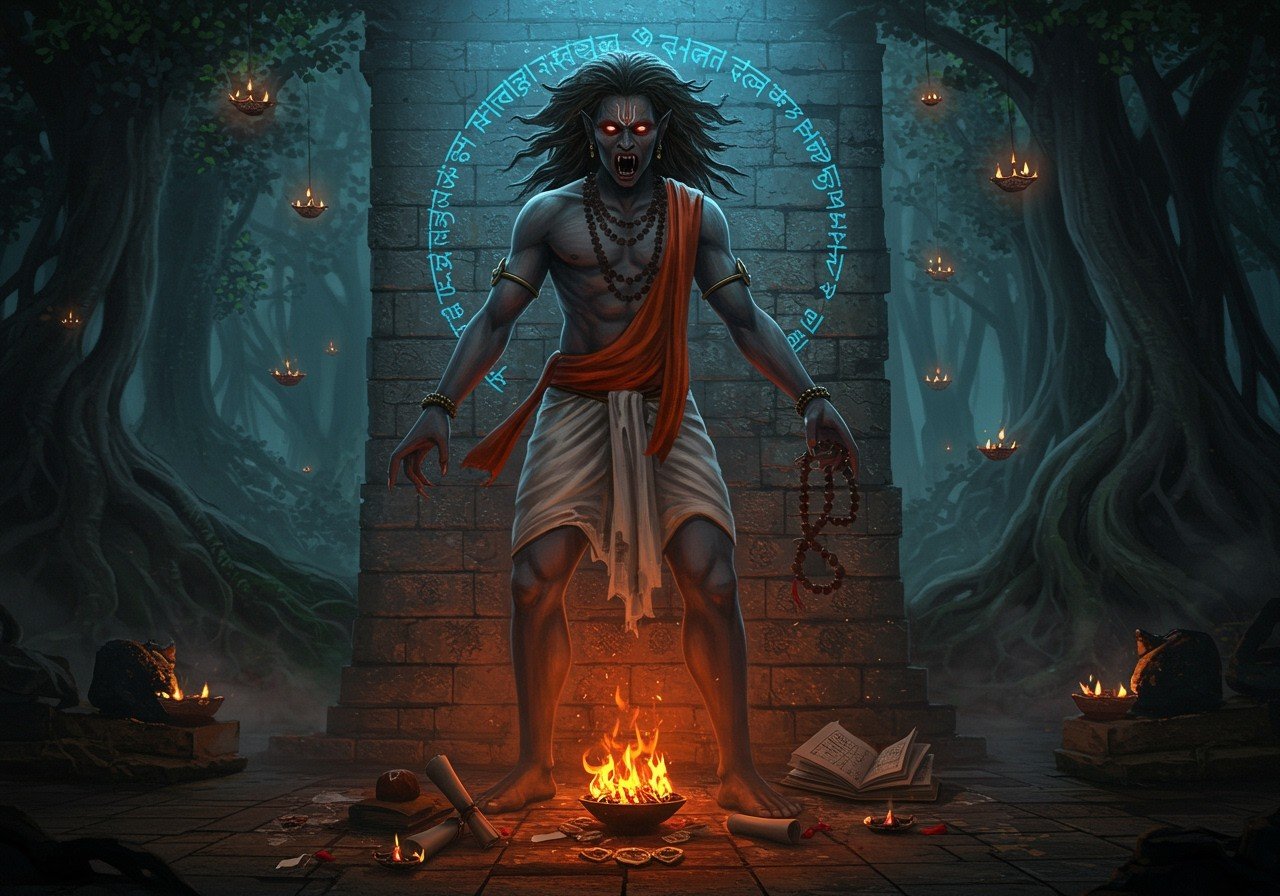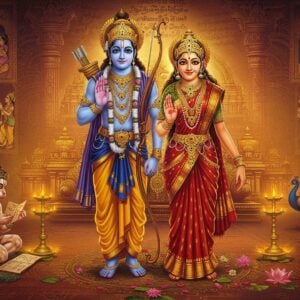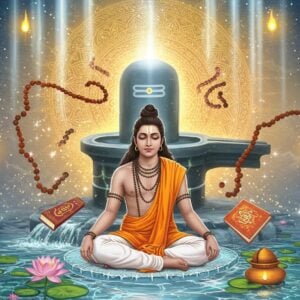
In the rich tapestry of Indian mythology, the Brahma Rakshasa stands out as a unique figure blending elements of spirituality, fear, and the possibility of redemption. This intriguing character reflects deeper aspects of human nature and morality within Hindu tradition. By exploring the Brahma Rakshasa, we gain insights into cultural beliefs and ethical values.
Origins of the Brahma Rakshasa
The term ‘Brahma Rakshasa’ combines ‘Brahma,’ the Hindu god of creation, and ‘Rakshasa,’ meaning demon. This fascinating figure originates from ancient Hindu scriptures. These scriptures are like the Puranas and Upanishads. The myth describes how learned Brahmins transform into Brahma Rakshasas. This is due to the misuse of their knowledge and power. Such transformations highlight the moral dimensions. Also, the consequences of misusing spiritual wisdom.
Stories from Hindu texts often depict Brahma Rakshasas as both knowledgeable and malevolent beings. These stories highlight the dangers of unrestrained ambition and the ethical responsibilities tied to knowledge. Their dual nature emphasizes these things. Understanding these origins helps us appreciate the complex narratives woven into this mythological character.
Legends and Lore Surrounding Brahma Rakshasas
In the vibrant world of Indian folklore, Brahma Rakshasa tales captivate with their blend of fear and wisdom. Across regions, these stories come alive with cultural nuances, weaving a rich tapestry of tradition. In the narrative world, Brahma Rakshasas often emerge as cautionary figures. They serve as a reminder of the dangers of straying from the righteous path. Stories of Brahma Rakshasas and other mythological figures are deeply ingrained in Indian culture. For a wide selection of spiritual and cultural products, visit Poojn.in.
Brahma Rakshasas in Traditional Tales
Take the Simhasana Dvatrimsika and Panchatantra, for instance. These ancient texts recount encounters with Brahma Rakshasas, portraying them as disruptors of rituals. They dislike prayers and sacrifices, often causing chaos in sacred spaces. These texts explore the complex relationship between knowledge and morality, highlighting the potential for even learned individuals to stray from the righteous path. Discover more about these ancient texts and their significance at Poojn.in’s blog.
Yet, these stories also offer glimpses of redemption. Some legends suggest that even Brahma Rakshasas can find liberation through penance or divine grace. Exploring these narratives reveals the potential for transformation and the hope that even those who have strayed can find their way back to righteousness. Deepen your understanding of these themes by exploring Hinduism’s diverse traditions.
Symbolism and Moral Lessons
The Brahma Rakshasa embodies unbridled ambition and misuse of spiritual knowledge. This symbolism serves as a powerful metaphor, cautioning against ethical lapses. It highlights the importance of humility, self-control, and the responsible use of power. These timeless themes resonate deeply with audiences, offering moral guidance. Delve into the rich symbolism of Hindu mythology with resources available at Poojn.in’s blog.
Influence on Modern Culture
The impact of Brahma Rakshasa legends extends beyond folklore into modern Indian literature, film, and television. Their stories adapt to contemporary contexts while retaining core themes of morality and redemption. Whether in books or on screen, the Brahma Rakshasa continues to intrigue and educate new generations. Learn more about the enduring influence of Hindu mythology on contemporary culture at Poojn.in’s blog.
Characteristics and Attributes of Brahma Rakshasas
Brahma Rakshasas possess a unique blend of physical and supernatural traits. Their fearsome appearance, often depicted with horns and a Choti (tuft of hair), strikes awe and fear. They are often associated with graveyards, forests, and desolate locations, adding to their mystique. Yet, they retain their scholarly wisdom, reflecting their origins as learned Brahmins. This combination creates a complex and compelling figure.
Supernatural Abilities
These spirits wield formidable powers. They can shape-shift, disguising themselves to deceive victims. Their immense strength and cunning make them formidable adversaries. Often found in forests and graveyards, they haunt places steeped in mystery. Their supernatural abilities contribute to the fear and awe they inspire.
The Dual Nature
The duality of Brahma Rakshasas lies in their transformation from virtuous scholars to vengeful spirits. This transformation speaks to the theme of moral decay when wisdom is misused. The Brahma Rakshasa embodies the potential consequences of unchecked ambition and the corruption of knowledge. It serves as a reminder of the ethical responsibilities tied to knowledge. This duality makes them a fascinating subject for exploration.
Artistic Depictions
In art and sculpture, Brahma Rakshasas are depicted with distinct iconography. Their fierce forms inspire awe and curiosity, evoking psychological responses ranging from fear to wonder. These artistic representations reflect the cultural significance of the Brahma Rakshasa and its enduring presence in the Indian imagination.
How to Get Rid of Brahma Rakshasas
Traditional rituals offer ways to appease or expel Brahma Rakshasas. Spiritual leaders, like priests and exorcists, play a vital role in these practices. These leaders possess the knowledge and expertise to conduct the necessary ceremonies and rituals. They perform ceremonies to cleanse spaces or individuals affected by these spirits. For authentic puja items and spiritual guidance, consider exploring the offerings at Poojn.in.
Rituals and Offerings
Specific mantras, prayers, and offerings hold spiritual significance in countering Brahma Rakshasa influence. These practices are rooted in ancient traditions and beliefs. These rituals emphasize themes of redemption and forgiveness. They aim to restore balance and harmony to the affected individual or space.
Contemporary Adaptations
As cultural practices evolve, so do interpretations of these rituals. Modern approaches often incorporate contemporary understandings while respecting traditional wisdom. Modern adaptations reflect the dynamic nature of tradition while maintaining respect for ancient beliefs. This adaptability ensures the continued relevance of these practices in a changing world.
Poojn.in offers a wide variety of products and services for those looking to connect with their spirituality and heritage. From puja items to sacred texts, Poojn.in is a valuable resource for those seeking to deepen their understanding and practice.
Poojn.in and Brahma Rakshasa Protection
While Poojn.in does not offer specific products or services related to Brahma Rakshasa protection, we do provide a wide range of items for puja and spiritual practices that can promote peace of mind and well-being. Explore our diverse collection of puja items, sacred texts, and other spiritual products to enhance your spiritual journey. Visit www.poojn.in or call 91 3369029784 for more information. All products come with quality assurance and proper packaging to maintain their sanctity.
Conclusion: Embracing Tradition and Wisdom
In the intricate tapestry of Indian folklore, Brahma Rakshasa tales weave lessons of morality, tradition, and the delicate balance between knowledge and power. These stories remind us that knowledge without ethical grounding can lead to negative consequences. These stories, rich with cultural wisdom, guide us through themes of redemption and ethical living. As we explore the legends of Brahma Rakshasas, we see not only the fearsome spirits but also the hope for transformation and liberation. Poojn.in offers a diverse range of spiritual and cultural products to enhance your understanding of these ancient traditions. Visit www.poojn.in to explore our collection.
By reflecting on these narratives, we connect with the past and find guidance for the present. These tales provide valuable insights into human nature and the importance of moral conduct. They remind us of the importance of humility and the responsible use of knowledge. As these tales continue to inspire new generations, they reaffirm our cultural heritage, offering both caution and wisdom. Embracing these stories helps us honor our traditions while navigating the complexities of modern life.
The Enigmatic Brahma Rakshasa: Frequently Asked Questions
What is a Brahma Rakshasa?
A Brahma Rakshasa is a fierce spirit in Hindu mythology, believed to be the soul of a Brahmin transformed into a Rakshasa due to misdeeds or unfulfilled duties.
Why does a Brahmin become a Brahma Rakshasa?
A Brahmin might become a Brahma Rakshasa due to greed, abuse of power, improper performance of duties, or incorrect funeral rites. These transgressions disrupt the natural order and lead to their transformation into vengeful spirits.
How can one identify a Brahma Rakshasa?
Brahma Rakshasas are described as powerful, intelligent spirits with a terrifying appearance and deep knowledge of scriptures and rituals. Their dual nature, combining scholarly wisdom with demonic traits, makes them distinct figures in Hindu mythology.
How can one get rid of a Brahma Rakshasa?
Traditional methods suggest conducting specific rituals and prayers, often with the guidance of a knowledgeable priest, to appease or expel a Brahma Rakshasa. These rituals aim to restore balance and harmony to the affected individual or space.
Are there stories of Brahma Rakshasas in Indian mythology?
Yes, several legends and stories in Indian mythology feature Brahma Rakshasas, often serving as moral lessons about the consequences of greed and improper conduct. These stories highlight the importance of adhering to one’s dharma and fulfilling one’s duties.
Can Brahma Rakshasas be benevolent or helpful?
While generally considered dangerous, some tales suggest that Brahma Rakshasas, through proper rituals and appeasement, might leave peacefully or even offer assistance. However, caution and respect are always advised when dealing with such powerful entities.
What are the origins of the Brahma Rakshasa myth?
The Brahma Rakshasa myth originates from ancient Hindu texts that warn against the consequences of not adhering to one’s dharma or duty. These texts emphasize the importance of ethical conduct and the potential repercussions of straying from the righteous path.


